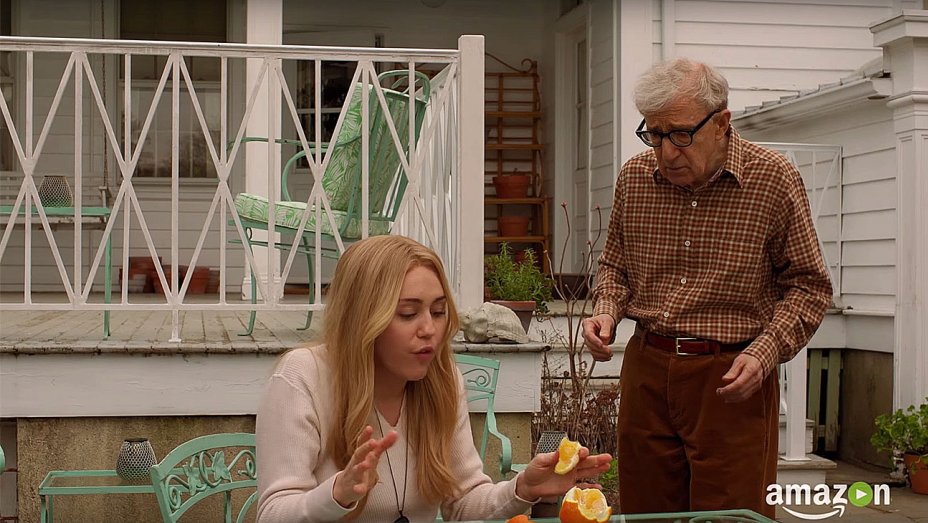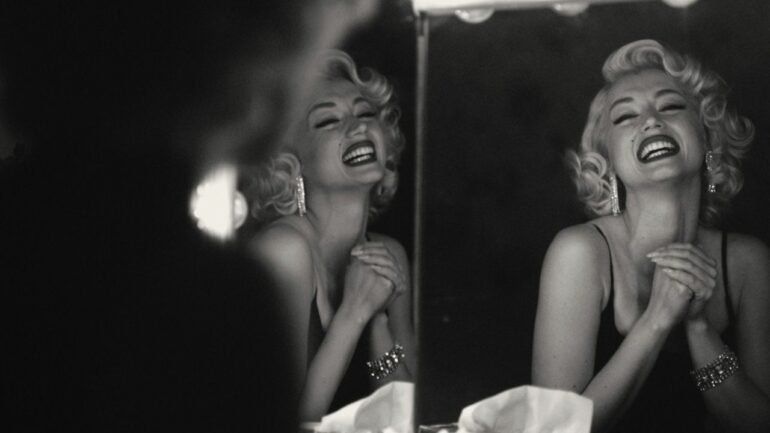So good... like you
Listeners:
Top listeners:
00:00
00:00
chevron_left
-
play_arrow
NGradio So good... like you
Woody Allen’s highly anticipated foray into television (via Amazon) stars Miley Cyrus, Elaine May and Allen himself in the story of a young 1960s radical and the elderly couple she moves in with.
If we are to believe legendary filmmaker Woody Allen when he speaks about his first-ever television series, Crisis in Six Scenes, he only did it because Amazon made him an offer he couldn’t refuse. He took no joy in making it, he doesn’t know if it will be any good and he doesn’t care if people like it or not.
Looking at his motivation for the project (which premieres Sept. 30) through the prism of his comments, it’s pretty obvious that he did it for the money, it was probably a bit of a headache and he prefers films — which likely means there won’t be a second season.
And that’s probably a good thing. Because Crisis in Six Scenes isn’t very good. It’s compelling in very infrequent, late-episode snippets and stacks up poorly against a plethora of current, artistically ambitious half-hours like FX’s Louie, Atlanta, Better Things and You’re the Worst; Amazon’s own Transparent, Catastrophe, Fleabag and One Mississippi; and Netflix’s Master of None, Hulu’s Casual and Starz’s The Girlfriend Experience.
That’s a short and probably incomplete list, but what it does, with some authority, is show that Allen either didn’t take seriously his venture into television or he simply finished something that pales in comparison to numerous other half-hours that attempt, in some way, a higher-caliber combination of comedy and drama.
And that’s pretty telling.
On the other hand, nobody should fault Amazon for asking him to do it. The idea that Woody Allen would do a television series was the unicorn dream of every channel out there, and a streaming service not named Netflix actually made the deal. It was a major coup even if, as is now apparent, the victory didn’t amount to much.
Crisis in Six Scenes unsurprisingly feels very much like a big-screen Allen offering, but somehow thinner and not smart enough in its premise. It’s not until the fifth and sixth episodes that you get the sense that Allen himself has become engaged and, frantically and pretty effectively for those episodes, gives himself over to the endeavor. If you were the most optimistic person on the planet you might envision a scenario where Allen realized on the late side that there was merit in short, serialized stories, and will somehow move past his very public and very apparent reservations and embrace the medium for a second season.
It’s unlikely he’d get much of whatever viewership materializes for Crisis in Six Scenes to come with him, since the first three half hours are a curiously plodding and frankly half-assed effort, the fourth episode has a minor spark of momentum and the last two episodes — by far the best — are sadly too little, too late.
The one thing Allen intriguingly seems to have nailed for a man who has shown zero interest in television is the very modern notion of binge-watching. Crisis in Six Scenes is absolutely best seen in one sitting (partly because if you stop anywhere in the first three episodes then you’re unlikely to return).

Allen sets Crisis in Six Scenes in the Vietnam War era, with the country appalled by the war and the loss of lives. People watch the nightly news document student revolts, an uprising of political protests in the African-American community and a general sense that all is not well in the United States.
Into this timeline — with even a wink in the direction of Patty Hearst — Allen has cast himself as Sidney Muntzinger, a not-very-successful author but formerly a successful advertising copywriter (of ridiculous products) who really wants to be J.D. Salinger (he even calls himself S.J. Muntzinger professionally).
There is an eyebrow-raising sub-joke that Sidney is writing a television series, a kind of sell-out to the dumb masses. That take on things (and let’s not forget Allen is more loyal to the movies than any living director) will furrow the brows of all the people who believe television has long surpassed movies as a medium for telling compelling, complicated, full-blown and grown-up stories.
Sidney is married to Kay (Elaine May), a therapist who sees clients at their upscale suburban New York home. Sidney and Kay are allowing their friend’s son Alan (John Magaro) to stay with them while he attends NYU, ostensibly so he can stay away from hippies and “druggies” and other undesirables as he sets about planning the marriage to his fiancée, Ellie (played by Rachel Brosnahan, formerly of Netflix’s House of Cards).
Everything is upended with the 4 a.m. arrival of Darlene “Lenny” Dale (Miley Cyrus), whose family took in Kay when her parents died and whom Kay therefore feels an obligation to welcome into her own home. Oh, right – Lenny is hiding because she’s a wanted fugitive, a member of the Constitutional Liberation Army who was busted out of jail. A guard was shot in the process. There’s a manhunt. Lenny is a full-blown radical, spouting all kinds of theory from Mao to Frantz Fanon.
That takes nearly three episodes to happen, and they are not very good episodes. Allen is Allen: neurotic. Lenny sees him as a symbol for the establishment, drugged by television and capitalism and his happy suburban life.
In the first three episodes, Lenny and Sidney bicker about class and politics. Some of it is amusing; most of it seems rehashed. Lenny likes Kay and Kay in turn pooh-poohs Sidney’s worries that they will be accomplices to a crime. In the meantime, their guest Alan is falling for the brashly revolutionary Lenny.
Cyrus does the best she can with what she’s given here, but she mostly comes off as a very young, probably misguided radical who thinks America can only work if it’s torn down and rebuilt. Her Lenny never seems dangerous, even though she’s not supposed to be super pampered.
Crisis in Six Scenes suffers from the fact that each episode barely hits 22 minutes — it’s an indication that Allen was probably stretching to fill his running time (lots of series creators in the streaming or premium cable world go well over the standard allotted time to tell their stories).
Crisis in Six Scenes isn’t bad when it simply observes the foibles of the aging play out with May and Allen (Kay belongs to a mostly elderly “book club”; Joy Behar looks to be the youngest in it). Elderly suburban white people not getting the point of 60s unhappiness even if they accidentally heard Buffalo Springfield’s “For What It’s Worth” seems to be the main joke here.
Still, there’s almost no momentum until Cyrus’s character infuses Kay and her book club with activist ideas (and even that joke gets a bit stretched thin).
There’s a moment when Allen’s constant anxiety and neurosis in the face of Cyrus’s radicalism becomes a kind of funny joke about being too put out to make change, even if you’re a liberal. There might be a bigger poke in the eye somewhere in Crisis in Six Scenes where Allen is making fun of liberals who talk the talk but are too tired to walk the walk, but it doesn’t come off if intended.
The best episodes are the last two, when Crisis in Six Scenes becomes a full-blown farce and we get to see Allen and May playing accidental aging radicals, shuffling around Brooklyn to help Lenny get to Cuba. When part of the plan goes awry, Sidney says, “We’re not professional criminals! You know, I’m writing a sitcom!” And Kay says, “It was our first time jumping roof-to-roof.”
By then, though, there’s not much to salvage in Crisis in Six Scenes, even with a stellar list of cameos (Lewis Black, Max Casella, Becky Ann Baker, David Harbour, etc). If you’re a die-hard Allen fan, you might enjoy his usual tics and riffs (as one of those fans, I admit I found these bits tired or half-baked here). When Kay seems intrigued by the “political philosophy” of Mao, Sidney says, “That’s not your business — you’re a suburban grandmother for God’s sake. You shouldn’t be thinking about radical politics; you should be thinking hip replacement.” When Alan becomes intrigued by Lenny, he says, “Sid, there’s something about her that’s turning me on” and Allen’s retort is: “Yes, Freud speaks of it — it’s called the Death Wish.”
Of course, watching Allen describe his medical worries to a doctor is still funny, whether he’s talking about weird feelings in his thumb or knee or, when all else fails in the face of his being pronounced perfectly fine: “Is there a possibility I have malaria?”
Enthusiasm for that shtick will vary based on love of Allen and how old you are, but there’s enough of it to be lightly amusing across about half of these episodes. But that’s not nearly enough. And, worse, the sum of Crisis in Six Scenes doesn’t even come remotely close to what other creators are doing in the medium with the half hours they’ve been granted. If Amazon was hoping a master filmmaker would use his imagination and skill to attack the most vibrant storytelling platform currently in the culture, it will instead have to satisfy itself with the knowledge that several of its own lesser-profile offerings by lesser-known creators are far superior.
At least they took their swing — even if Allen whiffed his.
Cast: Woody Allen, Elaine May, Miley Cyrus, Rachel Brosnahan, John Magaro
Created by: Woody Allen
Source: hollywoodreporter.com
Written by: New Generation Radio
Similar posts
ΔΗΜΟΦΙΛΗ ΑΡΘΡΑ
COPYRIGHT 2020. NGRADIO





















Post comments (0)